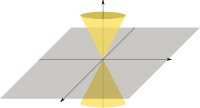Prof. Andreas Juhl - Publikationen
Monographien
Cohomological Theory of Dynamical Zeta Functions
Progress in Mathematics, vol. 194, Birkhäuser, 2001, 709 S.
Informationen zum Buch auf springer.com
The dynamical zeta functions in the title of this research monograph are generalizations of Selberg's zeta function. These functions are defined by the closed orbits (and their monodromies) of the geodesic flows of rank one locally symmetric spaces They can be studied by methods of automorphic forms (Selberg's trace formula) and hyperbolic dynamics (Ruelle transfer operators).
The monograph takes an intermediate point of view by systematically deriving the properties of the zeta functions from so-called dynamical Lefschetz formulas. These constitute analogs of Lefschetz fixed point formulas in which closed orbits take the role of fixed points. The relevant cohomology for that purpose is tangential cohomology of the stable foliation (Anosov structure) of the geodesic flow. The fact that the stable leaves of the geodesic flows define a Legendrian foliation of the sphere bundle puts the whole approach into the framework of eometric quantization. A central result is a natural description of the divisors of the Selberg zeta functions of compact locally symmetric spaces of rank one in terms of indices of canonical complexes. From that point of view, the functional equations of the zeta functions appear as duality theorems in index theory. Although the underlying dynamics largely motives the approach, the language of the book is dominated by representation theory and differential geometry.
Families of Conformally Covariant Differential Operators, Q-Curvature and Holography
Progress in Mathematics, vol. 275, Birkhäuser, 2009, 488 S.
Informationen zum Buch auf springer.com
The central object of this monograph is Branson's Q-curvature. This important and subtle scalar Riemannian curvature quantity in even dimensions was introduced by Thomas Branson about 15 years ago in connection with the study of variational formulas for determinants of conformally covariant differential operators.
In the book we develop a new approach which rests on a theory of families of conformally covariant differential operators which are associated to hypersurfaces in conformal manifolds. The new approach is at the cutting edge of many central developments in conformal differential geometry in the last two decades (Fefferman-Graham ambient metric, spectral theory on Poincare-Einstein spaces, tractor calculus, Verma modules and Cartan geometry). In addition, the theory of conformally covariant families is inspired by the idea of holography in the AdS/CFT-duality. Among other things, it naturally leads to a holographic description of Q-curvature.
Conformal Differential Geometry: Q-curvature and Conformal Holonomy (mit Helga Baum)
Oberwolfach Seminars, vol. 40, Birkhäuser, 2010, 165 S.
Informationen zum Buch auf springer.com
Conformal invariants (conformally invariant tensors, conformally covariant differential operators, conformal holonomy groups etc.) are of central significance in differential geometry and physics. Well-known examples of conformally covariant operators are the Yamabe, the Paneitz, the Dirac and the twistor operator. These operators are intimely connected with the notion of Branson’s Q-curvature.
The aim of these lectures is to present the basic ideas and some of the recent developments around Q -curvature and conformal holonomy. The part on Q -curvature starts with a discussion of its origins and its relevance in geometry and spectral theory. The following lectures describe the fundamental relation between Q -curvature and scattering theory on asymptotically hyperbolic manifolds. Building on this, they introduce the recent concept of Q -curvature polynomials and use these to reveal the recursive structure of Q -curvatures. The part on conformal holonomy starts with an introduction to Cartan connections and its holonomy groups. Then we define holonomy groups of conformal manifolds, discuss its relation to Einstein metrics and recent classification results in Riemannian and Lorentzian signature. In particular, we explain the connection between conformal holonomy and conformal Killing forms and spinors, and describe Fefferman metrics in CR geometry as Lorentzian manifold with conformal holonomy SU(1,m).
Neuere Artikel
mit C. Krattenthaler: Summation formulas for GJMS-operators and Q-curvatures on the Moebius sphere, Journal of Approximation Theory (2014), doi:10.1016/j.jat.2014.03.002. Preprint, arXiv:0910.4840 [math-DG].
On the recursive structure of Branson's Q-curvature, Math. Res. Lett., 21(3), S. 1-13 (2014). Preprint: arxiv:1004.1784 [math-DG].
Explicit formulas for GJMS-operators and Q-curvatures, Geometric and Functional Analysis 23(4) (2013), , pp 1278-1370. doi:10.1007/s00039-013-0232-9. Preprint: arxiv:1108.0273 [math-DG].
On Branson's Q-curvature of order eight, Conformal geometry and Dynamics, 15 (2011), 20-43. Siehe auch: arxiv:0912.2217 [math-DG].
mit Carsten Falk: Universal recursive formulas for Q-curvature., J. Reine Angew.Math., 652 (2011). Siehe auch: arXiv math-DG:0804.2745.
Holographic formula for Q-curvature II, Adv. in Math. 226 no. 4 (2011).
mit R.C. Graham: Holographic formula for Q-curvature. Advances in Mathematics, 216(2), S.841-853, 2007
Preprints
On conformally covariant powers of the Laplacian. Preprint, arXiv:0905.3992 [math.DG]


